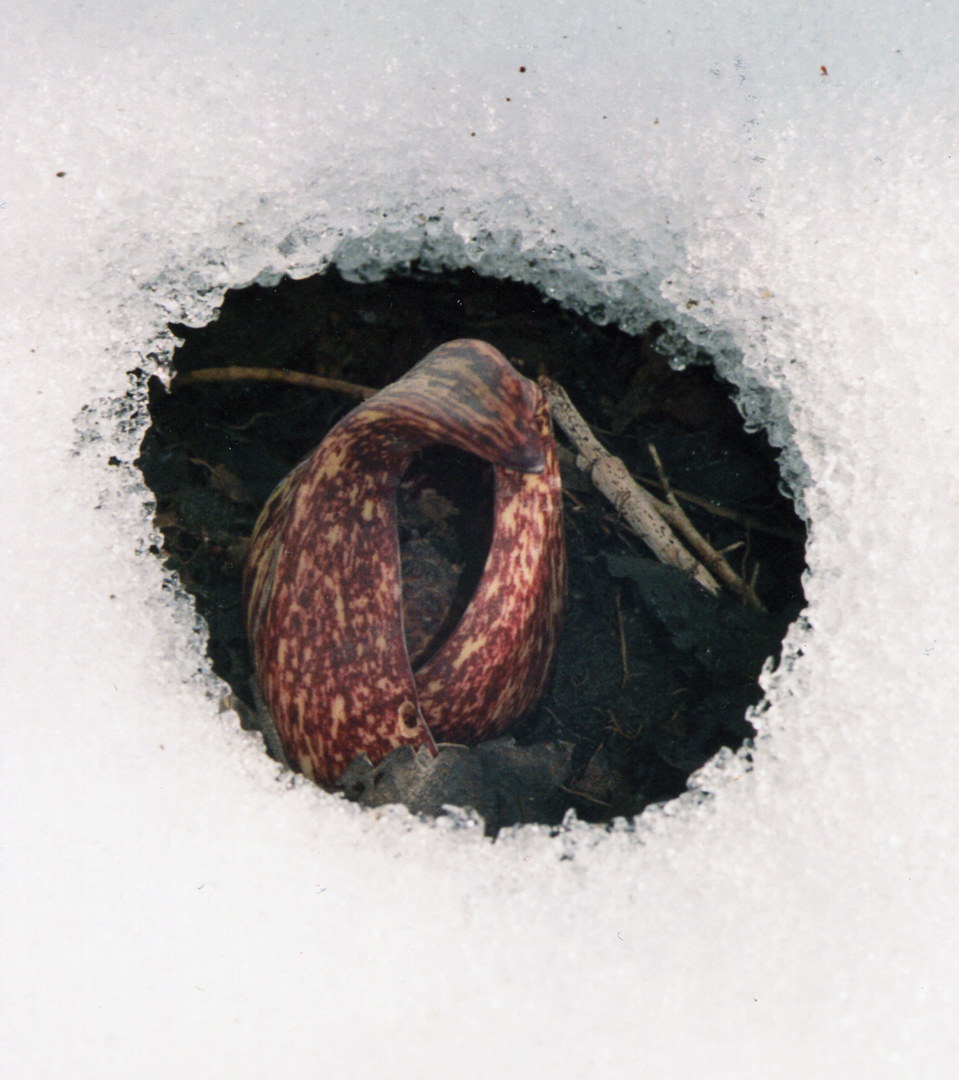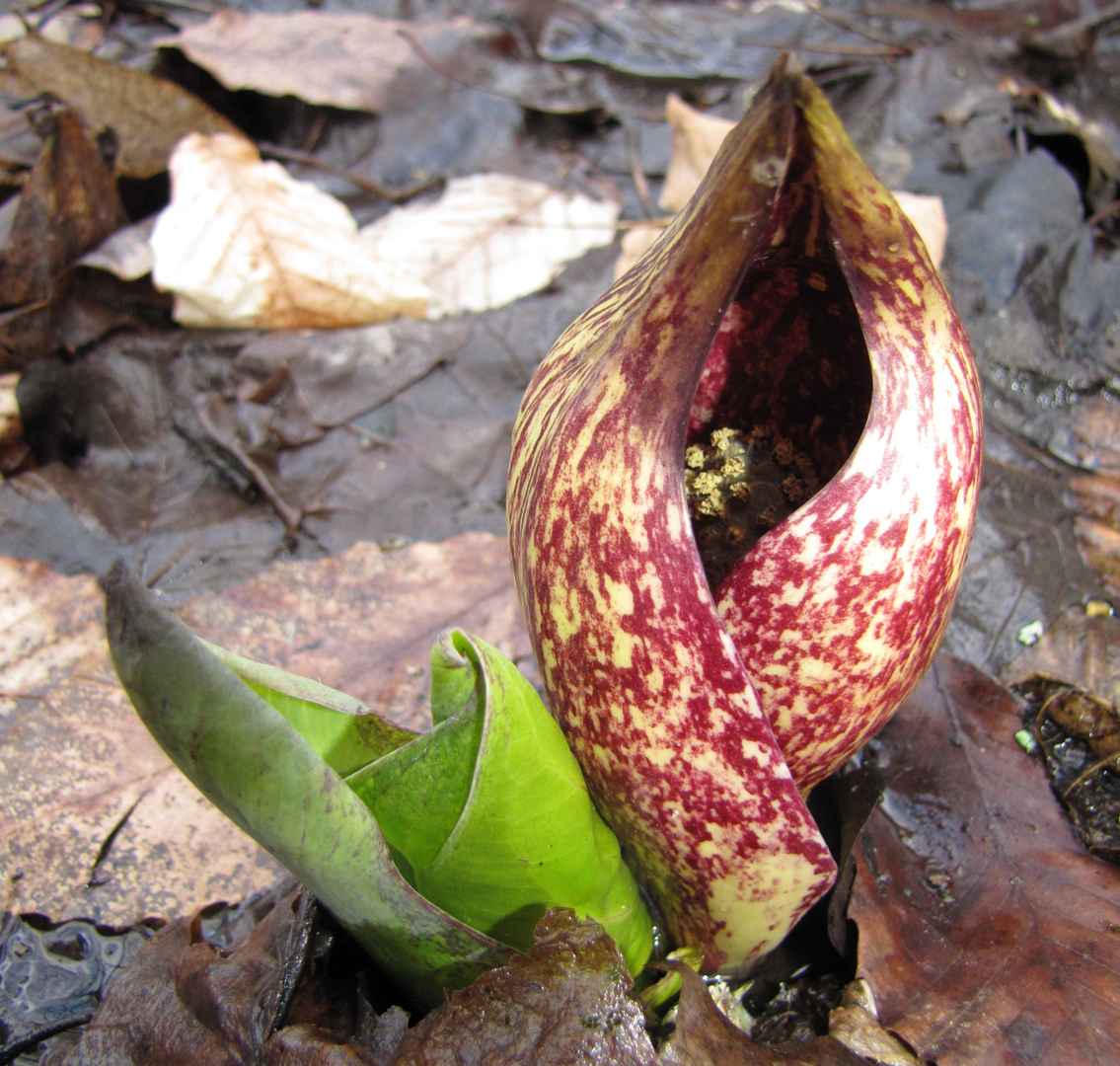
By February, most of us are tired of winter and are probably looking forward to spring with great anticipation. Some of us are even walking through the fields and forests in search of the first signs of spring. If you know where to look, you may find the first new wildflower of spring, the skunk cabbage. Skunk cabbage gets its name from the fact that the leaves emit a very foul odor whenever they are bruised or crushed. Local common names for skunk cabbage include bear’s foot, bear’s leaf, clumpfoot cabbage, elephant ears, fetid hellebore, and skunkroot.
Skunk cabbage flowers can be seen in winter, even when there is ice and snow on the ground. Respiration and other activities of the cells during its early winter growth leads to thermogenesis (thermo is Greek for “heat” and genesis is Latin for “birth”) of the flower’s salicylic acid and its related salicylates, which produces enough heat to melt the ice and snow and to allow the plant to push to the surface. The heat also releases and intensifies its odorous chemicals, which attracts some pollinating insects.
BEWARE THE CRYSTALS
The entire skunk cabbage plant contains sharp, needle-like crystals of calcium oxalate. If any part of this plant is tasted, these crystals can cause the mouth and throat to blister, burn, swell, or become extremely irritated. This can make breathing, speaking and swallowing difficult, at least for a time. Despite the presence of these crystals, parts of the skunk cabbage can be used for food or for medicine, if properly prepared before use. Aside from the calcium oxalate, skunk cabbage also contains iron, manganese, resin, silica, sulfur and tannin.
MEDICINAL USES

Although toxic if consumed in large doses, the roots and the rhizomes of skunk cabbage have so many medicinal uses that the plant was listed in the U.S. Pharmacopoeia from 1820 to 1882. The rootstocks have been used to treat asthma, bronchial catarrh, cancer, convulsions, cramps, delirium tremens, diabetes, edema, epilepsy, hysteria, intestinal worms, nervous disorders, parturitions, pertussis, scurvy, tetanus, and toothaches. A root poultice was used for treating bruises, sores, swellings and wounds, and was also used as an underarm deodorant.
One Native American tribe sniffed the roots (and the rolled up leaves) as a treatment for migraine headaches. Another tribe mixed the powdered skunk cabbage with dyes from other plants. They used sharp fish teeth as a needle and made body tattoos from the mix. These illustrated tattoos were used as charms to ward off diseases.
Skunk cabbage roots are best harvested in fall, after the first frost has killed the leaves, or in early spring. If the rootstocks are gathered for medicinal uses, they should be used as soon as possible because they will lose their potency after a period of time. The seeds of the plant are believed to be more potent than the rootstocks and will retain their potency longer.

EDIBLE USES
The rootstocks and the young, unfurled leaves of skunk cabbage can also be used as food. The plant itself contains vitamin C. Before performing any food preparation, the leaves and the rootstocks must be washed thoroughly. Cold water is preferred. Drying the plant can remove the calcium oxalate crystals from the roots. The roots should be dried for at least five to six weeks.
Boiling the leaves in several changes of salt water (along with a pinch of baking soda) can remove both the crystals and the foul smells. The leaves should be boiled for at least 20 minutes. The water should be changed whenever its color darkens. The roots may have to be boiled for up to three days.
Some Native American tribes roasted the roots in pits with hot coals for two to three days. The roasting was supposed to destroy the calcium oxalate crystals. Today, the roots may only need to be roasted in an oven for at least an hour.
The dried or boiled young leaves are edible and can be added to soups and stews. The dried roots can be ground into flour. Some people claim that the flour tastes like cocoa.
There have been no known cases of any fatalities from eating raw skunk cabbage. It’s doubtful that any person or domestic animal would have ever taken a second bite of it!
GORDON MITCHELL
Resource Management Technician
JOIN OUR GUIDED SKUNK CABBAGE PROGRAMS IN FEBRUARY
Prairie Oaks
Stinky Skunk Cabbage
Sat Feb 18, 3pm
Take a 1-mile off-trail hike to find the first and smelliest flower of spring. (Prairie View Picnic Area)
Clear Creek
Metro Five-0 (Level 4): Skunk Cabbage Hike
Tue Feb 21, 1pm
Enjoy a rugged 3.5-mile backcountry hike and see Ohio’s earliest blooming wildflower. Age 50 and older (Park Office)
Blendon Woods
Skunk Cabbage Hunt
Sun Feb 26, 11am
Search for the winter blooming flower along our creeks on a 2-mile hike. (Nature Center)
